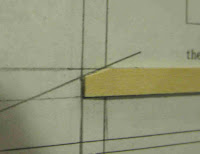The lower tunnels are 5 1/2" long, much longer than a root edge of a fin.
If you were to lay a bead of glue down the joint and smooth it with a finger, you would have a lot of (drying) glue to remove by the time you got to the bottom of the tunnel.
You should tackle the fillet in sections.
Smooth the first third of the glue bead and wipe the glue off your finger. After wiping off your finger, rub off any dried glue skin off your fingertip before smoothing anymore of the remaining fillet bead. Any little bits of glue left on your finger will transfer off your finger and leave unsightly glue lumps in your otherwise smooth fillet.
After being sure your finger is clean, smooth the second 1/3 of the glue bead.
Again, wipe the excess glue off your finger. Remove the glue "skin" off your finger.

So you won't end up with a blob of glue at the end of the tunnel -
Turn over the body tube and smooth the remaining 1/3 of the fillet by going up and away from the end of the tunnel.

Check the tunnel ends and remove any wet glue with a Q-tip.
Here I'm smoothing out the the glue at the tunnel end with a toothpick.

















































